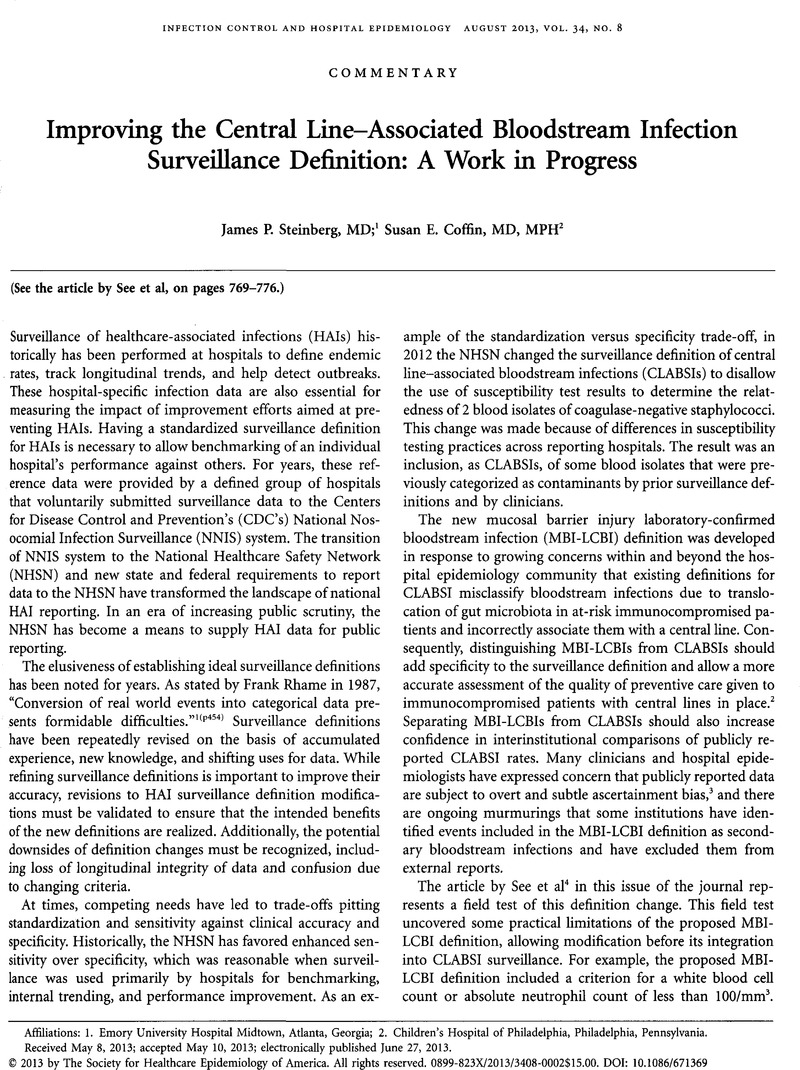Crossref Citations
This article has been cited by the following publications. This list is generated based on data provided by Crossref.
Bundy, David G.
Gaur, Aditya H.
Billett, Amy L.
He, Bing
Colantuoni, Elizabeth A.
and
Miller, Marlene R.
2014.
Preventing CLABSIs Among Pediatric Hematology/Oncology Inpatients: National Collaborative Results.
Pediatrics,
Vol. 134,
Issue. 6,
p.
e1678.
Åttman, Emilia
Aittoniemi, Janne
Sinisalo, Marjatta
Vuento, Risto
Lyytikäinen, Outi
Kärki, Tommi
Syrjänen, Jaana
and
Huttunen, Reetta
2015.
Etiology, clinical course and outcome of healthcare-associated bloodstream infections in patients with hematological malignancies: a retrospective study of 350 patients in a Finnish tertiary care hospital.
Leukemia & Lymphoma,
Vol. 56,
Issue. 12,
p.
3370.
Metzger, Kristen E.
Rucker, Yvonne
Callaghan, Mary
Churchill, Michelle
Jovanovic, Borko D.
Zembower, Teresa R.
and
Bolon, Maureen K.
2015.
The Burden of Mucosal Barrier Injury Laboratory-Confirmed Bloodstream Infection among Hematology, Oncology, and Stem Cell Transplant Patients.
Infection Control & Hospital Epidemiology,
Vol. 36,
Issue. 2,
p.
119.
Chaftari, Anne-Marie
Jordan, Mary
Hachem, Ray
Al Hamal, Zanaib
Jiang, Ying
Yousif, Ammar
Garoge, Kumait
Deshmukh, Poonam
and
Raad, Issam
2016.
A clinical practical approach to the surveillance definition of central line–associated bloodstream infection in cancer patients with mucosal barrier injury.
American Journal of Infection Control,
Vol. 44,
Issue. 8,
p.
931.
Zakhour, Ramia
Chaftari, Anne-Marie
and
Raad, Issam I
2016.
Catheter-related infections in patients with haematological malignancies: novel preventive and therapeutic strategies.
The Lancet Infectious Diseases,
Vol. 16,
Issue. 11,
p.
e241.
Torres, Dara
González, Miriam L.
Loera, Adriana
Aguilera, Marco
Relyea, George
Aristizabal, Paula
and
Caniza, Miguela A.
2016.
The Centers for Disease Control and Prevention definition of mucosal barrier injury-associated bloodstream infection improves accurate detection of preventable bacteremia rates at a pediatric cancer center in a low- to middle-income country.
American Journal of Infection Control,
Vol. 44,
Issue. 4,
p.
432.
Balian, Chelsea
Garcia, Michelle
and
Ward, Jessica
2018.
A Retrospective Analysis of Bloodstream Infections in Pediatric Allogeneic Stem Cell Transplant Recipients: The Role of Central Venous Catheters and Mucosal Barrier Injury.
Journal of Pediatric Oncology Nursing,
Vol. 35,
Issue. 3,
p.
210.
Kato, Yukiko
Hagihara, Mao
Kurumiya, Ai
Takahashi, Tomoko
Sakata, Miki
Shibata, Yuichi
Kato, Hideo
Shiota, Arufumi
Watanabe, Hiroki
Asai, Nobuhiro
Koizumi, Yusuke
Yamagishi, Yuka
and
Mikamo, Hiroshige
2018.
Impact of mucosal barrier injury laboratory-confirmed bloodstream infection (MBI-LCBI) on central line-associated bloodstream infections (CLABSIs) in department of hematology at single university hospital in Japan.
Journal of Infection and Chemotherapy,
Vol. 24,
Issue. 1,
p.
31.
Civitarese, Anna M.
Ruggieri, Eric
Walz, J. Mattias
Mack, Deborah Ann
Heard, Stephen O.
Mitchell, Michael
Lilly, Craig M.
Landry, Karen E.
and
Ellison, Richard T.
2019.
RE: Preventability of hospital onset bacterermia and fungemia: A pilot study of potential healthcare-associated infection outcome measure, by Dantes et al (2019).
Infection Control & Hospital Epidemiology,
Vol. 40,
Issue. 10,
p.
1209.
Couk, Jesse
Chernetsky Tejedor, Sheri
Steinberg, James P.
Robichaux, Chad
and
Jacob, Jesse T.
2019.
Impact of multiple concurrent central lines on central-line–associated bloodstream infection rates.
Infection Control & Hospital Epidemiology,
Vol. 40,
Issue. 9,
p.
1019.
Scrivens, Nicholas
Sabri, Elham
Bredeson, Christopher
and
McDiarmid, Sheryl
2020.
Comparison of complication rates and incidences associated with different peripherally inserted central catheters (PICC) in patients with hematological malignancies: a retrospective cohort study.
Leukemia & Lymphoma,
Vol. 61,
Issue. 1,
p.
156.
Hakim, Hana
Billett, Amy L.
Xu, Jiahui
Tang, Li
Richardson, Troy
Winkle, Cynthia
Werner, Eric J.
Hord, Jeffrey D.
Bundy, David G.
and
Gaur, Aditya H.
2020.
Mucosal barrier injury–associated bloodstream infections in pediatric oncology patients.
Pediatric Blood & Cancer,
Vol. 67,
Issue. 8,
Dube, William C.
Jacob, Jesse T.
Zheng, Ziduo
Huang, Yijian
Robichaux, Chad
Steinberg, James P.
and
Fridkin, Scott K.
2020.
Comparison of Rates of Central Line–Associated Bloodstream Infections in Patients With 1 vs 2 Central Venous Catheters.
JAMA Network Open,
Vol. 3,
Issue. 3,
p.
e200396.
Beaudry, Josephine
and
ScottoDiMaso, Kathleen
2020.
Central Line Care: Reducing Central Line–Associated Bloodstream Infections on a Hematologic Malignancy and Stem Cell Transplant Unit.
Clinical Journal of Oncology Nursing,
Vol. 24,
Issue. 2,
p.
148.
Åttman, Emilia
Syrjänen, Jaana
Lyytikäinen, Outi
Ollgren, Jukka
Sinisalo, Marjatta
Vuento, Risto
Mattila, Erja
and
Huttunen, Reetta
2021.
Healthcare‐associated blood stream infections in hematological patients in Finland during the years 2006‐2016.
European Journal of Haematology,
Vol. 107,
Issue. 3,
p.
311.
Böll, Boris
Schalk, Enrico
Buchheidt, Dieter
Hasenkamp, Justin
Kiehl, Michael
Kiderlen, Til Ramon
Kochanek, Matthias
Koldehoff, Michael
Kostrewa, Philippe
Claßen, Annika Y.
Mellinghoff, Sibylle C.
Metzner, Bernd
Penack, Olaf
Ruhnke, Markus
Vehreschild, Maria J. G. T.
Weissinger, Florian
Wolf, Hans-Heinrich
Karthaus, Meinolf
and
Hentrich, Marcus
2021.
Central venous catheter–related infections in hematology and oncology: 2020 updated guidelines on diagnosis, management, and prevention by the Infectious Diseases Working Party (AGIHO) of the German Society of Hematology and Medical Oncology (DGHO).
Annals of Hematology,
Vol. 100,
Issue. 1,
p.
239.
Belloni, Silvia
Caruso, Rosario
Cattani, Daniela
Mandelli, Giorgia
Donizetti, Daniela
Mazzoleni, Beatrice
and
Tedeschi, Michele
2022.
Occurrence rate and risk factors for long‐term central line‐associated bloodstream infections in patients with cancer: A systematic review.
Worldviews on Evidence-Based Nursing,
Vol. 19,
Issue. 2,
p.
100.
Eichenberger, Emily M
de Vries, Christiaan R
Ruffin, Felicia
Sharma-Kuinkel, Batu
Park, Lawrence
Hong, David
Scott, Erick R
Blair, Lily
Degner, Nicholas
Hollemon, Desiree H
Blauwkamp, Timothy A
Ho, Carine
Seng, Hon
Shah, Pratik
Wanda, Lisa
Fowler, Vance G
and
Ahmed, Asim A
2022.
Microbial Cell-Free DNA Identifies Etiology of Bloodstream Infections, Persists Longer Than Conventional Blood Cultures, and Its Duration of Detection Is Associated With Metastatic Infection in Patients With Staphylococcus aureus and Gram-Negative Bacteremia.
Clinical Infectious Diseases,
Vol. 74,
Issue. 11,
p.
2020.



